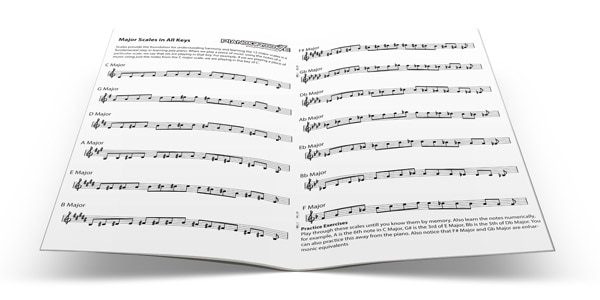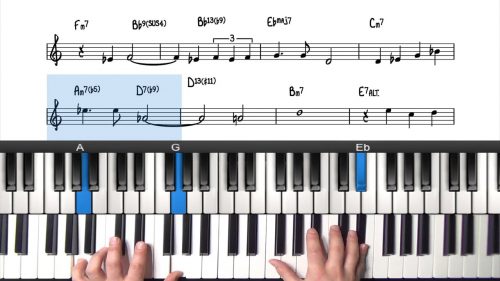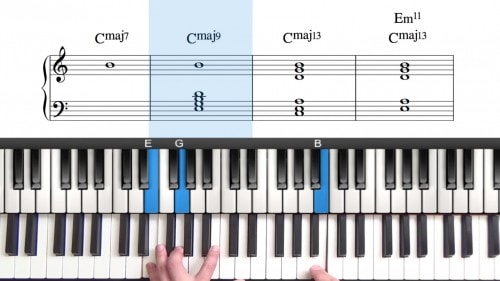Herbie Hancock Voicing Tutorial
The Herbie Hancock voicing is a rich-sounding, two-handed minor 11th chord. The voicing contains a 5th interval in the left hand (Root & 5) and then four notes in the right hand (b3, 11, b7 & 9). The best way to learn the voicing is to memorise these scale degrees and then apply it to any minor key.
Downloadable PDF Lesson Supplement
Download the Herbie Hancock voicing in all 12 keys. This is a great reference for practicing this voicing:
The voicing is named after Herbie Hancock who is one of the most famous modern jazz pianists and composers. Herbie was one of the first jazz pianists to embrace synthesizers and funk music.
Minor Chords With The 9th In The Melody
As the top note in the voicing is the 9th – look out for minor chords with the 9th in the melody and then simply slot this voicing underneath.
Lesson Downloads
-
Herbie Hancock Voicing – 12 Keys File Type: pdf
-
Herbie Hancock Voicing Worksheet File Type: pdf
Practice Tips
-
Practice this voicing by taking it through all 12 keys. You can do this chromatically by moving up or down the keyboard.
-
The voicing is more difficult to play in some keys - don't fret about this. Just make a note of the keys that you can play it in and find alternate minor voicings to use for the other keys.
-
Also try using the voicing in different registers of the piano. It sounds great in the lower registers because of the 5th interval in the left hand.
-
Remember that the 5th interval can be played low down in the bass without sounding too muddy.








When playing along a melody, would you use this voicing mostly when the melody note is the ninth of the chord?
Hi Matt, apologies for the late reply – this comment slipped past me. Yes that is exactly when you would use this voicing. This is because the highest note in the voicing is the 9th and so you can simply ‘slot’ the voicing underneath. When playing jazz standards, you should always be consciously analysing the melody note in terms of the scale degree of the chord. Then if you know that a particular voicing has that scale degree on top, it makes it much quicker and easier to find a suitable voicing – no matter what key you are in! Hope this helps. Cheers, Hayden.
Makes sense! Thank you.
Hayden, I have a question about fingering for these chords: I noticed that for most of them, you’re playing both the RH adjacent minor third and ninth notes with your thumb, and haven’t seen that technique before. I often have difficulty getting my fingers around these chords – Cm11 is especially awkward bc of the Eb and F, which is one where the 2-notes-at-once technique doesn’t work. I was just wondering how you’d come across that fingering technique and how common it is in jazz piano playing.
Hi Hayden, this is great, thanks. What is the difference between the HH minor 11 voicing, and the So What minor 11, and the Kenny Barron minor 11 ? I have been practising all of them, but am curious about how to apply them to melodies and improvisation. Cheers.
Hi Natasha,
The difference is the melody note, or the top note of the voicing.
It’s very important to try memorise the scale degree at the top of the voicings that you learn, for example…
The top note of the So What Voicing is the 5th and so on a jazz standard, whenever you come across a minor chord (in any key) with the 5th in the melody, the So What Voicing will sound great.
The Kenny Barron Voicing has the 11th on the top so this is a great minor voicing when the 11th is in the melody.
The Herbie Hancock Voicing has the 9th in the melody so this will be a good choice of voicing when you come across the 9th in the melody over a minor chord.
Hope this helps and if you would like me to elaborate on this let me know 🙂
Thanks, Hayden
Thanks Hayden, much clearer now.
That’s great Natasha… I’m glad it’s making more sense! Cheers, Hayden
Hi Hayden, further to my previous question, on the Kenny Barron worksheet, there is a Major #11 variation, is that used when the melody note is a # 11 ? Thanks.
Hi Natasha, yes that is absolutely correct!
One distinction that you should be aware of is that the #11 is only ever played on major chords whereas the other 3 voicings mentioned below are minor chord voicings.
You would always play the natural 11th on a minor chord.
You can play the natural 11th on a major chord but it sounds very dissonant due to the half step interval between the major 3rd and the 4th (the 4th is the 11th) and so it’s usually raised by a half step to the #11 to avoid this dissonance. This then becomes the Lydian Mode which you can use to play over major chords.
Have you watched these two lessons?…
Major Chord Variations: https://www.pianogroove.com/jazz-piano-lessons/major-voicing-variations/
Minor Chord Variation: https://www.pianogroove.com/jazz-piano-lessons/minor-voicing-options/
They are slightly more advanced than this lesson but it should help with your understanding of voicings options and it goes into more detail on what I just explained above.
Hope this helps and any further questions just let me know 🙂 Hayden
Hi Hayden, thank you for your patient and detailed explanations. I will watch the 2 lessons you mentioned. I live in Melbourne, Australia, and we have a yearly jazz festival, which is always really fantastic http://melbournejazz.com/ Cheers
My pleasure Natasha, if I can help you with anything else just let me know.
The jazz festival in Melbourne looks great! I was just checking out the headline events… http://melbournejazz.com/information/ticketing
‘The Kenny Barron Trio’ would definitely be one to watch and if you like Bossa Nova…. ‘Jobim’s Masterpieces’ looks like an awesome show 🙂
Cheers, Hayden
I am new to improv, voicings. You open and close playing. Would it be possible to get an arrangement of your playing the tune in its entirety, or just play it with the two keyboards, so I can watch and copy. It really helps. Thanks.
HI Richard,
I have added an additional lesson to this course on improvising over Tenderly, you can find it here: https://www.pianogroove.com/jazz-piano-lessons/tenderly-tutorial-part-2/
I break down everything that you see in this lesson.
It does incorporate some of the more advanced theory from our course on Altered Harmony & Upper Structure Triads.
Check out the lesson and let me know if I can help further.
Cheers, Hayden
Hi Hayden
Regarding describing scale degrees when should one use e.g. “flat 3rd” versus “minor 3rd”? Another example – when describing the A minor voicing you said it included the minor 3rd and flat 7th.
Thanks
John
Hi John,
Good question!
Yes I do use these terms interchangeably. I am referring to the same note if I say “b3” / “minor 3rd” or “b7” / “minor 7th” … so always keep that in mind.
You will hear different musicians refer to these tones in both ways. You could even say “the 3 of the minor chord”.
When we come to chord alterations in the following courses we have more example of this. For example, the #11 or b5 – both of which are the same note (enharmonic equivalents) but some musicians prefer one term over the other. The same applies to the #5 and b13.
Ultimately, it is the same note and one of the confusing things with jazz is that there is no definitive or standardised terminology list.
My recommendation would be to go with the term that makes the most sense for you.
I hope that helps John and let me know if you have any further questions.
I have been meaning to re-record these lessons to improve the visual quality and so when I get around to that I will standardise the expressions I use in the lesson to avoid confusion.
Cheers, Hayden
Big fan of 1960s Herbie Hancock, both as a front man and with Miles. Can you please give a couple of examples of where he uses the minor 11 voicing that now bears his name? Guessing there are a few in Maiden Voyage and Dolphin Dance? Thanks!
Hey Phillips 👋
That’s a great question and sorry for the late reply. I twisted my ankle at jazz fest weekend and I’ve been a little slow to catch up with student support.
The main characteristic of this voicing is the minor 3rd and the 11th voiced tightly together – in this instance in the middle of the chord.
There are lots of other applications of that cluster, for example a rootless voicing with the minor 3rd, 11th, and minor 7th in the left hand, and then the 9th, 5th, and 9th in the right hand. That’s a very nice rootless voicing with that cluster at the bottom of the chord.
Try to identify what is giving this voicing its distinctive character and then listen to some Herbie records and see what you can pick up.
In the interim I will find at least one example for you of this exact voicing being played by Herbie, and post it here.
Cheers, Hayden
ps. you might like this lesson on Cluster Voicings: https://www.pianogroove.com/jazz-piano-lessons/cluster-voicings/